
Andy Lloyd's Dark Star Blog

Blog 30 (September 2015)
The Origin of the Extended Scattered Disk
Last month, I discussed new research about the origin of the scattered
disk object named Sedna, as well as 2012 VP113
(1). This new work by
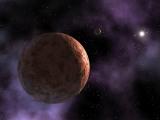
However, Dr Mike Brown, the discoverer of Sedna, is less sure that such a dramatic fly-by is the cause. Instead, he thinks that Sedna was simply pulled away from the Sun into its rather odd orbit by the Sun's siblings. If the Star Q hypothesis is indeed correct, however, he has predicted what we might expect to discover in the future when more scattered disk objects, like Sedna, are observed:
"...Sedna discoverer Mike Brown of the California Institute of Technology contends that the object most likely is native to our solar system and got yanked outward by the gravitational tug of the sun's siblings—a simpler scenario.
"The issue may remain unresolved until more objects with odd orbits are found in the outer reaches of our solar system. “When we have something like a dozen, I think we'll probably know,” Brown says. If the sun stole these objects from Star Q, they should all come closest to Earth on the same side of the sun. But if their orbits differ, the sun probably is innocent of theft." (1)
The difference between a 'gravitational tug of the sun's siblings' and the close incursion of a 1.8MS star from the same birthing pool as the Sun may seem like splitting hairs. But Dr Brown's solution leaves open the door for the Sedna-effect to have been caused by a closer, bound sub-stellar object - like a brown dwarf companion which, I imagine he would argue, has since been lost from the solar system. At least we now have a scientific argument which enables us to decide one way or the other in the coming years.
Other academic astronomers specialising in the outer solar system maintain that the objects in the extended scattered disk, beyond the Kuiper Belt, are possibly being shepherded by an as-yet undiscovered Planet X body. In other words, the anomalous orbital properties of Sedna, and 2012 VP113 were not driven by a stellar fly-by, or by the ancient intrusion of a stellar sibling, but by an extant planetary body somewhere beyond the Kuiper Belt:
"Sheppard noted that there may also be something bigger lurking in the region as there are hints of a possible planet that is bigger than Pluto and possibly bigger than the Earth. In a report published in the journal Nature in 2014, Sheppard and Chad Trujill (sic)
(4), from the Gemini Observatory in Hawaii, compiled evidence that suggests there could be a massive perturber or a large gravitationally disturbing object that lurks at the outer Solar System."“A massive object or great disturber would perturb or disturb anything that came close to it. So objects that stay away from the great disturber would be the most stable objects,” Sheppard explained. “Thus the great disturber can “shepherd” objects into similar types of orbits with similar arguments of perihelion which are the orbits which constantly keep the smaller objects away from the bigger object.”
"Although many astronomers agree that the planet does not exist, the idea of its existence was revived by a small number of scientists trying to find an explanation for the anomalies that were observed in the outer Solar system." (5)
The extended scattered disk objects exhibit properties which appear to collectively form a pattern, suggestive of a perturbing influence. As the number of these objects steadily grows, the pattern is strengthening; both in a qualitative way, but also in terms of more closely defining the source.
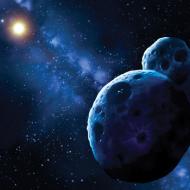
The implication of this emerging pattern is discussed here by Dr Brown and Dr Sheppard in recent interviews with 'The Washington Post':
"Mike Brown, the Caltech astronomer who discovered the dwarf planet Eris, tells us [The Washington Post] by e-mail, "Scott's claim is that all of these objects come to perihelion at the ecliptic, and all are going from below the plane to above the plane at perihelion."
"So there's something seemingly non-random, indeed a striking pattern, in how these extremely distant objects move around the sun. And that suggests that there's something out there influencing them -- or, more precisely, making other types of orbits unstable.
"Sometimes patterns involving small numbers of objects or events disappear upon further investigation. The 2014 paper (4) was based on just a dozen objects. But Sheppard is preparing a new paper based on more recent discoveries: "We found a few more extreme Kuiper Belt objects and they continue to follow the trend."
"The solar system is not completely explored. As Brown puts it: "There is a not insignificant chance that there are Earth-mass or larger objects yet to be discovered in the outer solar system."" (6)
Written by Andy Lloyd, 7-10th September 2015
References:
1) A. Lloyd "The Origins of Sedna" 15 August 2015
andylloyd.org/darkstarblog29.htm
2) Lucie Jilkova et al. "How Sedna and family were captured in a close encounter with a solar sibling" 4 August 2015
3) Ken Cresswell "Sun Accused of Stealing Planetary Objects from Another Star" 18 August 2015, with thanks to Lee
scientificamerican.com article
4
) Chadwick Trujillo & Scott Sheppard "A Sedna-like body with a perihelion of 80 astronomical units" Nature, 507: 471–474, 27 March 20145) Donald Morris "NASA's New Horizons Probe to Search Mysterious Planet X in the Kuiper Belt" 7 September 2015 (article on longer online) with thanks to Barry
6) Joel Achenbach "Is there a Planet X, a ‘massive perturber,’ hidden beyond Pluto?" 3 September 2015, with thanks to Barry
Another Surprise from Amazing Little Enceladus
As if the plumes of water streaming out into space from Saturn's little moon Enceladus weren't enough, it now transpires that it has been wobbling around along its orbital path to such an extent that the very rigidity of its interior has been brought into question:
"Using the data collected by the spacecraft scientists looked at seven years worth of photographs, carefully logging its position using craters as markers. What they found was that Enceladus' orbit was unlike anything they'd seen before. Not only was it changing speed as it moved around the gas giant, but it also had a slight wobble. They then took this wobble and applied it to various structural theories and found that only one composition could allow for such a degree of movement.
"Matthew Tiscareno, a Cassini participating scientist at the SETI Institute, Mountain View, California, said, "If the surface and core were rigidly connected, the core would provide so much dead weight the wobble would be far smaller than we observe it to be, this proves that there must be a global layer of liquid separating the surface from the core."
"This remarkable composition means that the moon's rocky centre almost 'floats' inside the ice-shell that surrounds it with Saturn's gravitational pull causing the core to move independent of its surface, thus creating the wobble." (1)
It had already been confirmed that Enceladus must have an extensive sub-surface ocean lying below about 20 miles of ice (2). This in itsel, has some profound implications for the potential for life within a moon orbiting a distant gas giant, and therefore my Dark Star Theory (3).
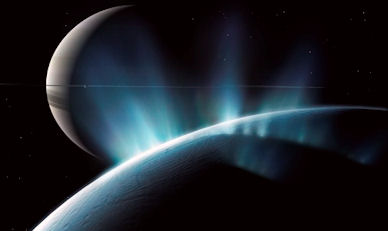
But now it appears that that liquid ocean must be a global phenomenon, encased within a thick, spherical sheet of ice. Within that ocean, the planet's rocky core is free to move within Saturn's strong gravitational field, providing a measureable wobble across the entire moon. This, in turn, is creating new headaches for planetary scientists, pushing the boundaries of theory still further - as can be gleaned from the abstract of the Icarus paper:
"This value [a physical libration of 0.120 ± 0.014°]
is too large to be consistent with Enceladus’s core being rigidly connected to its surface, and thus implies the presence of a global ocean rather than a localized polar sea. The maintenance of a global ocean within Enceladus is problematic according to many thermal models and so may constrain satellite properties or require a surprisingly dissipative Saturn." (4)
Written by Andy Lloyd,
17th September 2015
References:
1)
Thomas Tamblyn "Saturn's Moon Enceladus Has A Global Subsurface Ocean" 16 September 2015, with thanks to Je2) Press Association "Saturn's Moon Enceladus Has Huge Ocean Deep Under Icy Surface" 3 April 2014
3) Andy Lloyd "Enceladus's Ocean and the Dark Star Theory" 19 April 2014
andylloyd.org/darkstarblog13.htm
4) P.C. Thomas et al. " Enceladus’s measured physical libration requires a global subsurface ocean", Icarus, 264: pp. 227-238, 2016,
New Images of Pluto Show Frozen Methane Oceans
The rich and often bizarre topography of Pluto has been revealed in far greater deal as new photos continue to get sent back by the New Horizons probe, digitally (and manually) processed by computer, to create the most incredible images yet of the outer world. Although scientists had been fully expecting to find frozen nitrogen on the surface of Pluto, the variable extent of frozen methane across the planet's surface has been a real surprise.
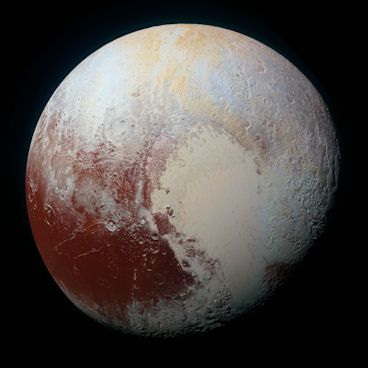
Image credit: NASA/JPL/Alex Parker
Methane is, of course, a hydrocarbon, and Pluto is covered in the stuff. One particular zone which is rich in methane also shows a strong spike in carbon monoxide, meaning that carbon, hydrogen and oxygen are all present in this frozen, primordial hydrocarbon soup.
"Sputnik Planum was already strange for being home to the one unique bulge in carbon monoxide concentrations, but now we’ve learned it’s also rich in methane. This is in sharp contrast to the surrounding older, more rugged regions. The dark, heavily cratered Cthulhu Regio to the immediate south of the plains is near-absent of methane except for a few isolated ridges and rims, as are the mountains flanking the western boundary. Outside of Sputnik Planum, methane seems to favour crater rims while avoiding the bowls, and concentrate in bright plains while avoiding darker regions. But it’s hard to know which way the causation goes. Are these areas brighter because they’re coated in fresh, bright methane ice, or is the ice more likely to condense in those brighter regions?" (1)
NASA thinks it most likely that the abundant methane is primordial, "inherited from the solar nebula from which the solar system formed 4.5 billion years ago", and not the by-product of space cows (2). Given the remarkable complexity on Pluto's surface, what, I wonder, is going on beneath the surface? Does a richer concoction of hydrocarbons lie beneath these surface features, warmed by Pluto's traumatised inner core and its proximity to the large moon Charon? In other words, does the presence of these simple compounds on the surface, methane and carbon dioxide, lead us to expect a load of organic chemistry going on within?
The surface features of Pluto are incredibly varied: Mountains, glaciers, dunes, gullies, ridges and scallops; all vying for the attention of geophysicists. Many of the formations and variations are not only highly intriguing, but also incredibly beautiful.
Written by Andy Lloyd,
25th September 2015
References:
1)
Mika McKinnon "New, Insanely High-Resolution Pluto Images Include More Color—and Weird "Snakeskin" Textures" 24 September 20152) Lillian Gipson (Ed) "New Horizons Update: Methane Detected; New Images of Pluto and Charon; Sunrise/Sunset Observations" 1 July 2015
Possible Uses for Perchlorates on Mars
NASA
held a big news conference today (Monday 28th September) about the discovery of running, liquid water on the surface of Mars. Far from being an ancient flow of water which had left its mark across the landscape of a desicated world, this finding reflects changing features on the surface of Mars observed over the last few years.
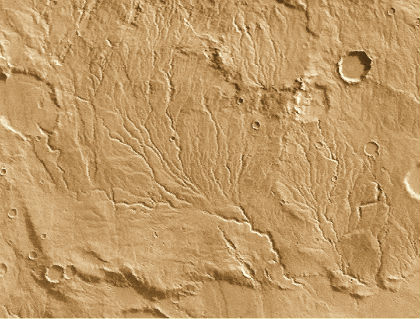
Ancient River beds on Mars
In other words, there is a seasonal flow of water (almost certainly a concentrated salty brine) currently taking place on Mars - a concept that, until very recently, was thought to be absolutely out of the question.
"New findings from NASA's Mars Reconnaissance Orbiter (MRO) provide the strongest evidence yet that liquid water flows intermittently on present-day Mars. Using an imaging spectrometer on MRO, researchers detected signatures of hydrated minerals on slopes where mysterious streaks are seen on the Red Planet. These darkish streaks appear to ebb and flow over time. They darken and appear to flow down steep slopes during warm seasons, and then fade in cooler seasons. They appear in several locations on Mars when temperatures are above minus 10 degrees Fahrenheit (minus 23 Celsius), and disappear at colder times." (1)
An educated guess as to the content of this press release was correct made by NASA watcher Keith Cowling (2), based upon positive developments in circulation regarding the origins of the observed "recurring slope lineae", the name given to these dark, streaky features observed on some steep Martian crater rims. Spectroscopic analysis has failed to show clear water on the surface. Instead, water appears to be penetrating into salt soils, forming dark brines. The seasonal variation suggests that the effect occurs when the Martian surface is at its warmest, and the dark colours retreat during the harsher seasons.
However, there are a number of factors which remain unknown, not least because these effects are observed in some craters, but not others. The source of the water is also unknown. There is speculation that the water is absorbed directly from the atmosphere by the salty soils in a chemical process known as deliquescence (3), a process enabled by perchlorates as I have discussed on the Dark Star blog previously (4). The NASA press release provides more details:
"Ojha and his co-authors interpret the spectral signatures as caused by hydrated minerals called perchlorates. The hydrated salts most consistent with the chemical signatures are likely a mixture of magnesium perchlorate, magnesium chlorate and sodium perchlorate. Some perchlorates have been shown to keep liquids from freezing even when conditions are as cold as minus 94 degrees Fahrenheit (minus 70 Celsius). On Earth, naturally produced perchlorates are concentrated in deserts, and some types of perchlorates can be used as rocket propellant." (1)
Rocket propellant freely available on the Martian surface? That's handy... Let's jump into the realm of Zecharia Sitchin's theories for a moment. He proposed that aliens (known as the Anunnaki in the ancient Mesopotamian texts which recorded their mythical endeavours), not unlike us in appearance (there's a reason for this...) visited the inner solar system in the past, colonising Earth (to mine for gold), but also Mars (5).
I've often wondered why the Anunnaki might have gone to Mars; a harsh, inhospitable world of seeming little strategic importance. They wanted gold here on Earth, says Sitchin (something to do with repairing the atmosphere of their world, Nibiru, which may be synonymous with Planet X). Maybe they were harvesting something else on Mars? Maybe Mars was their refuelling depot for the long journey back home?
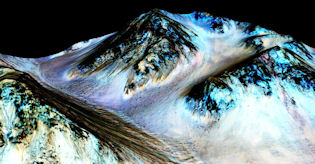
Seasonal darkening of some crater rim gullies indicates
current aqueous processes are at work. Image Credits: NASA/JPL/University of Arizona Here's some info about the
most common perchlorate used in rocket fuels: "Ammonium
perchlorate composite propellant is typically used in
aerospace propulsion applications, where simplicity and
reliability are desired and specific impulses (depending
on the composition and operating pressure) of 180–260
seconds are adequate. Because of these performance
attributes, APCP is regularly implemented in booster
applications such as in the Space Shuttle Solid Rocket
Boosters, aircraft ejection seats, and specialty space
exploration applications such as NASA's Mars Exploration
Rover descent stage retrorockets. In addition, the
high-power rocketry community regularly uses APCP in the
form of commercially available propellant "reloads", as
well as single-use motors. Experienced experimental and
amateur rocketeers also often work with APCP, processing
the APCP themselves." (6) It's one thing to travel to planets; quite another to
get off them again, and an even bigger leap to
fuel up for the long journey into the outer solar
system.
I can quite imagine that the Anunnaki were capable of synthesizing rocket fuels (Sitchin
always talked about rockets, of course, never anti-grav
UFOs) but why synthesize it when you can just harvest
the stuff out of the ground? If amateur rocketeers can
knock this stuff up fairly readily, then the Anunnaki
should have had little trouble. Such a
possibility has been considered before: "While
manufactured perchlorate for rocket propellant or
fireworks is relatively commonplace, naturally occurring
perchlorate is extremely rare on our planet. It is only
known to exist in a few very dry places such as Death
Valley, California and in fairly high concentration in
the Atacama Desert in Chile, the driest place on Earth.
Mars is much drier than even the driest place on Earth,
so it is not surprising that perchlorate is present
there. Scientists hypothesize that perchlorate forms
naturally when volcanic activity releases a chlorine
compound that undergoes chemical changes in the
atmosphere and then falls back to the surface. It only
stays put in the soil if it doesn’t get washed away.
Scientists think that this process might be the same on
both Earth and Mars. So, future Mars colonists listen
up: you can’t eat the dirt on Mars, but you might be
able to turn it into rocket fuel."
(7) Perchlorates are fairly toxic (just to add more
complexity to any missions to Mars, either by us or by
'them') and extracting clean water from these brines
could be a problem. However, some microorganisms are
known to live on these compounds on
Earth, which elevates the possibility of that same kind
of life thriving on Mars. Here's a paper about getting oxygen out of the
perchlorates, which also would obviously be very
helpful: "Perchlorate
(ClO4 −) is widespread in Martian soils at
concentrations between 0.5 and 1%. At such
concentrations, perchlorate could be an important source
of oxygen, but it could also become a critical chemical
hazard to astronauts. In this paper, we review the dual
implications of ClO4 − on Mars, and propose a
biochemical approach for removal of perchlorate from
Martian soil that would be energetically cheap,
environmentally friendly and could be used to obtain
oxygen both for human consumption and to fuel surface
operations." (8) So these compounds, readily available
on the Martian surface, could provide the oxygen needed
to survive on Mars as well as the rocket fuel to get
back to Planet X/Nibiru. The low gravitational
pull of Mars, combined with its poor atmosphere, make it
an ideal world from which to embark upon a long rocket
trip. Mars may not be so useless after all.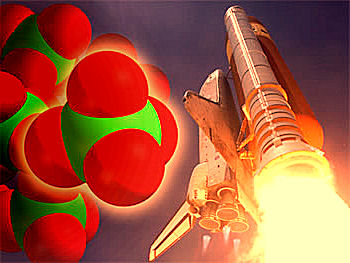
Written by Andy Lloyd,
28th September 2015
References:
1)
NASA press release "NASA Confirms Evidence That Liquid Water Flows on Today’s Mars" 28 September 20152) Keith Cowing "NASA Will Reveal a "Major Science Finding" About Mars on Monday" 25 September 2015,
3) A. McEwan et al. "Recurring Slope Lineae on Mars: Atmospheric Origin?" European Planetary Science Congress 2015, Vol. 10, EPSC2015-786-1, 2015,
meetingorganizer.copernicus.org doc
4) A. Lloyd "The Curious Waters of Mars" 17 April 2015
andylloyd.org/darkstarblog25.htm
5) Zecharia Sitchin "The Twelfth Planet" Avon 1976
6) "Ammonium perchlorate composite propellant"
7) Mary Beth Wilhelm "Don’t Eat the Dirt on Mars: the Pros and Cons of Perchlorate" 11th February 2014
8) Alfonso F. Davila et al. "Perchlorate on Mars: a chemical hazard and a resource for humans", International Journal of Astrobiology, Volume 12: 4, pp 321-325, October 2013
News from Ancient Sites
There were a couple of fascinating developments in the field of archaeoastronomy this month.
Firstly, a new line of stones, dating back some 4500 years, has been discovered very close to the Stonehenge monument in Wiltshire, England (1). The 90 stones, each of which may be as high as 15', were toppled some time ago, and are buried under the earth. They were recently discovered using ground radar techniques. The line of stones, probably Sarsens, is set along the south-eastern ridge of an ancient earthwork site. The potential archaeoastronomical significance of this will not be lost of readers of this blog, I would imagine, although this is merely hinted at by the archaeologists who discovered it. Rather, they think the stones are some kind of ritual or theatrical device set into the landscape to impress. Yeah, right. It seems much more likely that they are designed to mark out points on the horizon where the Sun, Moon and stars rise.
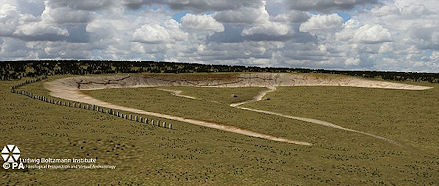
Why the stones were subsequently toppled remains a mystery:
"Prof [Vince]
Gaffney [of the University of Bradford] believes the stones may have been planted by the same people who built Stonehenge, but is sceptical about a direct link between the two monuments. They were placed along a steep slope, or scarp, cut into a natural dry valley to form a C-shaped feature. Precisely why the stones were put there remains a mystery. Part of Durrington Walls is aligned with the rising sun on the winter solstice, the shortest day of the year, which may be significant. The archaeologists believe that at some stage the stones were pushed over and incorporated into the emerging henge. This was not an act of vandalism but a deliberate attempt to preserve whatever it was about the stones that seemed so important." (1)The ancient landscape around Stonehenge appears to be literally littered with additional sites which, through the use of ground-penetrating radar, are only now coming to our attention.
The second item of interest is a new article written by Andrew Collins about the even older site of Göbekli Tepe in Turkey (2). The article is probably a bit too speculative in terms of targeting a specific constellation, in sharp contrast to the very restrained analysis by the academic astronomers working on 'Stonehenge 2', but it's nevertheless an informative read with an excellent selection of images.
Written by Andy Lloyd,
28th September 2015
References:
1)
Colin Fernandez "Stonehenge II is found! Radar search reveals giant line of standing stones from 4,500 years ago - buried three feet down, just one mile from famous Wiltshire site" 7 September 20152) Andrew Collins "First Pictorial Representation of Gobekli Tepe Found" 17 September 2015, with thanks to Lee
Our Solar System: An Alternative Birth
A very welcome email from a French researcher, François Berguerand, who initially contacted me a while back for permission to use an image in his book, which he has now published. He has sent me an excerpt from the book discussing aspects of his theory which have relevance to the Planet X debate. Here's his email of 7th September 2015:
Hello Andy,
Encore merci pour votre autorisation d'utilisation de votre image sur la planète X. Mon livre est enfin publié. Hélas je n'ai pas encore pu chercher à en faire une traduction anglaise. Il me faut d'abord tenter de rembourser mes frais de participation à l'édition par la vente de mon livre en français !
Pour info auprès de vos amis qui pourraient être intéressés et s'ils peuvent lire et comprendre le français voici le site de mon éditeur sur lequel passer commande:
(no longer available online, but a book by Francois may be found here:
Pour vous Andy qui avez été très sympa avec moi voici des extraits de l'ouvrage dont la partie qui vous passionne sur la ou pour moi les planètes X. Dans ma dernière pièce jointe il s'agit du chapitre :
"La surprise du Chef créateur. Sedna, Némésis et Tyche (planète X et G1.9)"
Merci encore pour votre aide et gentillesse.
François Berguerand (1)
Here's a translation of the author details and book synopsis from Amazon.fr:
"The author is a scientist, holding a degree in Physics and Nuclear Chemistry from the University of Advanced Studies. An engineer and consultant, he was responsible for major international energy projects during 40 years in the industry. Now retired, he devotes his free time to writing scientific books, giving lectures and inventing patented industrial equipment. A researcher in the fields of energy-matter and gravitational control, he is an astronomy and astrophysics enthusiast. His theory about the birth of our solar system is a rigorous analysis of previously held assumptions and inconsistencies over centuries. His argument is that the worlds of the solar system may have had a double origin: arising from a gas condensation nuclei, increased later by the capture of enormous quantities of meteors following a very particular near-collision."
It's easy to misinterpret when reading complex material like a new physics theory in a foreign language, and, unfortunately, this work is not yet available in English. But from what I can gather from reading extracts of the book in French, and from email exchanges between myself and François, his hypothesis involves the need for a large transiting star to facilitate the formation of planets. In a way, the transiting star, which in the case of the solar system would actually need to be more massive than the Sun, acts like a catalyst does in a chemical reaction, but in this case gravitationally.
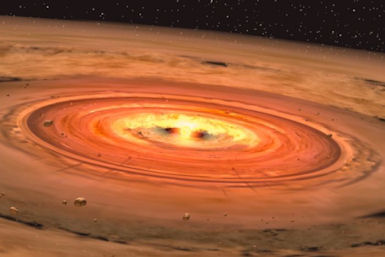
Image Credit: NASA/CalTech/JPL
According to Berguerand, the large transiting star draws out material from the Sun in a spindle-like way, which is partly stabilized by the two stars' opposing gravitational forces. There is an additional factor stabilising this emerging 'spindle' of erupted material, and that is the existing cloud of nebular material in place around the Sun mainly since the beginning of the near-collision. This spindle-shaped globular mass of erupted material continues to rotate around the Sun, tearing as it does so into smaller globules. These then cool rapidly, coalescing into rotating gaseous balls which then go on to form the planets. This model then neatly explains the varying sizes of the planets we see in the solar system:
"The formerly spindle-like mass explains why the main large planets, Jupiter and Saturn, emerge from the middle of the spindle. Because of the important gravitational attraction of the massive transiting star, the spindle is still a little bit large externally, so giving us Neptune and Uranus. All other planets result from the tearing at both thin extremities of the spindle. Closer to the Sun, in the nebular cloud, are heavy asteroids absorbed by Mercury, Venus, Earth and Mars. Externally are lighter icy materials in the nebular cloud." (2)
The implication of this idea is that planetary formation is not necessarily an automatic process shortly after the birth of a new star, but may be an event that occurs some time later due to a stellar fly-by. Most likely, the transiting star would have arisen within the same stellar nursery, and would thus have been in reasonably close proximity to the subject star from an early stage.
How would this help us in our understanding of the early solar system? I suppose the main change would be that for the Sun to have its own planetary system (an a priori position) it had to have experienced a flyby from another large star, rather than having been a solitary star throughout. That allows for the transmission between the two systems of material; comets, planets, possibly even sub-brown dwarfs. Thus, there would, I guess, be an expectation of anomalous material and orbital paths in the outer solar system, as the underlying assumptions of how the planetary system forms in the first place are fundamentally different.
Critics would likely argue that this adds a degree of unnecessary complexity to the whole process of planetary systems. Indeed, young stars are routinely observed to have proto-planetary disks in place that appear regular and coherent within the standard accretion model for planetary systems. Recently, for instance, large dust disks have been found around red dwarfs stars by astronomers working with data from the WISE infra-red sky survey (3) which hare providing fresh insight into the processes thought to be involved in long-lived dwarf stars:
"We also identify two new lithium-rich members of the neighbouring Scorpius–Centaurus OB Association (Sco–Cen). Both exhibit large 12 and 22 μm excesses and strong, variable Hα emission which we attribute to accretion from circumstellar discs. Such stars are thought to be incredibly rare at the ~16 Myr median age of Sco–Cen and they join only one other confirmed M-type and three higher mass accretors outside of Upper Scorpius. The serendipitous discovery of two accreting stars hosting large quantities of circumstellar material may be indicative of a sizeable age spread in Sco–Cen, or further evidence that disc dispersal and planet formation time-scales are longer around lower mass stars." (4)
So why drag in the need for a stellar flyby to catalyse the process? Well, there are problems with the standard accretion model, problems which often call for fundamental migrations of sizeable planets within the system over time for the models to be successful. What causes those migrations? Are there not external factors at play in any case?
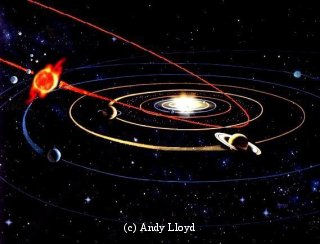
As far as Sitchin's Celestial Battle scenario goes, one might imagine that the usurper Marduk, a sub-brown dwarf in my Dark Star revision of his theory, rides into the nascent Solar System on the tailcoat of a flyby star, and becomes captured by the Sun during the melee. The issue would be how well formed is the Sun's planetary system by that point? How old is the Sun by then in comparison? What Berguerand brings to the table is the potential for the timings to be radically different from what has been previously considered. It's worth bearing in mind.
Written by Andy Lloyd,
25th September 2015
References:
1)
Correspondence from François Berguerand, 7 September 20152) Correspondence from François Berguerand, 29 September 2015
3) Stuart Gary "Red dwarf stars provide clues to how planets form" 16th September 2015, with thanks to Lee
4) Simon Murphy et al. "New members of the TW Hydrae Association and two accreting M-dwarfs in Scorpius–Centaurus" MNRAS, 453 (3): 2220-2231, 1 November 2015
mnras.oxfordjournals.org article
'Le Baiser de l'Hôtel de Ville' Painting
Continuing the French theme, I've recently completed a new painting: "Le Baiser de l'Hôtel de Ville" ("The Kiss at the Town Hall"). It's based upon an iconic photograph by Robert Doisneau (1950) which I recreated as a colour painting (September 2015, 14" x 10" acrylic on canvas).
"Le Baiser de l'Hôtel de Ville" (2015) by Andy Lloyd
Creating colour paintings from black and white photos is challenging to say the least.
There's a story behind this one:I originally painted this famous scene in 2006. The photograph is a favourite of Fiona's. This month, I received an email requesting use of the image of the painting in a film about Robert Doisneau. The film is being produced by his family, for the French TV channel 'Arte'. Hi
s grand-daughter, Clementine Deroudille, wants to include several recreations of the photo in the movie, to show it's status as "a cliché all around the world".As I sold the orig
inal to a lady in Windsor some years ago (no, not that lady...), I decided to recreate the painting this week, so I could provide Robert Doisneau's family with a high definition image of the work. I'm very proud to be involved in this project. As far as I know, my paintings are the only attempts to create a colour version of the classic black and white photo. Fingers crossed that they use it.You can obtain your own print of this image here:
painting
Gloucester, Holm of Rugby
As anyone who has experienced a premiership match from 'The Shed' will tell you, Gloucester has a mighty strong passion for rugby. For the benefit of American readers who aren't acquainted with rugby, it's a bit like (American) Football, but without all that health-and-safety nonsense. There are two forms of it, Union and League. In England, Union is usually played in the south of the country, League in the north. Union is the bigger game both here, and internationally, and this month the sport's World Cup has been held in England and Wales. Some say that the Rugby World Cup is the third biggest sporting event in the world, but such a claim seems rather tenuous (1). Nevertheless, with teams from over 100 countries competing to make it into the finals, and with an ever widening global reach to sports-mad TV audiences, rugby is on the up.

Photo courtesy of Mike Lloyd
Tickets for the four World Cup matches being held at Gloucester's stadium, Kingsholm, were hard to come by, but my brother managed to get hold of two tickets for the Tonga versus Georgia match. An amazing experience! Rugby is huge here, out of all proportion to Gloucester's size as a cathedral city of about 130,000 people. Sports 'legacy' is often over-hyped, but it's been a great honour for the city to be a host for several World Cup games, and it has created a level of excitement here that will be a positive influence for many years to come.
If you still don't know much about the sport, you should check it out. Lose that body armour and helmet, and get stuck in!
Written by Andy Lloyd,
Reference:
1)
Matt Slater "Olympics and World Cup are the biggest, but what comes next?" 4 December 2014

You can keep informed of updates by following me on Twitter:
![]()
Or like my Facebook Page: https://www.facebook.com/darkstarandylloyd